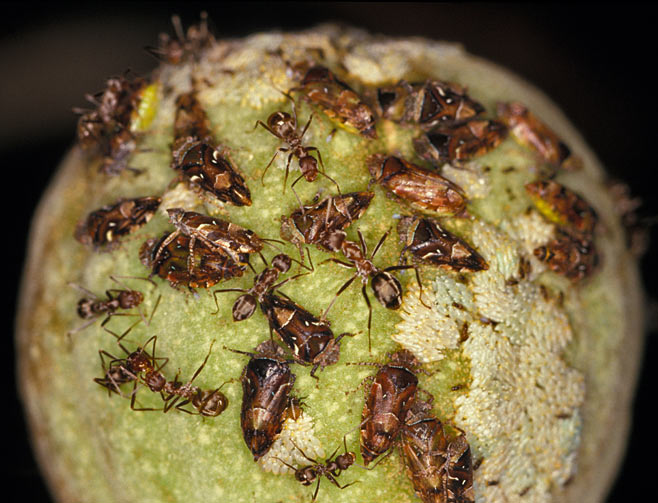|
Hilda patruelis
Life
> Eukaryotes >
Opisthokonta >
Metazoa (animals) > Bilateria > Ecdysozoa
> Panarthropoda > Tritocerebra > Phylum:
Arthopoda > Mandibulata >
Atelocerata > Panhexapoda >
Hexapoda
> Insecta (insects) > Dicondyla > Pterygota >
Metapterygota > Neoptera > Eumetabola > Paraneoptera > Condylognatha
> Hemiptera (bugs) >
Auchenorrhyncha > Fulgoroidea > Family:
Tettigometridae
 |
|
Hilda patruelis on a wild fig and being tended for honeydew by pugnaceous ants Anoplolepis
custodiens. On the right hand side is a large batch of eggs and on the eggs are tiny
little encyrtid parasitic wasps (probably Psyllechthrus oophagus) that parasitise
the eggs. [photo H. Robertson ©] |
Hilda patruelis is by far the most common of the three
species of tettigometrid recorded from southern Africa and is found on a
wide range of host plants including
groundnuts and
wild fig trees Ficus species. Like
many other bugs, Hilda attracts ants by expelling droplets of sugary liquid called
honeydew. It has been found that on fig trees, the ants attracted by Hilda drive
off the parasitic wasps that parasitise the larvae of the fig wasp pollinator and thus
benefit the tree by increasing pollinator production. They also increase plant fitness by
driving off seed predators as well.
Further Reading
-
Compton, S.G. & Robertson, H.G. 1988. Complex interactions between mutualisms: ants
tending homopterans protect fig seeds and pollinators. Ecology 69: 1302-1305.
-
Weaving, A.J.S. 1980. Observations on Hilda patruelis Stal. (Homoptera:
Tettigometridae) and its infestation of the groundnut crop in Rhodesia. Journal of the
Entomological Society of Southern Africa 43: 151-167.
|
